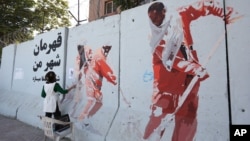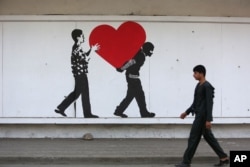A city at war, the Afghan capital is among the ugliest in the world.
Wide avenues once lined with rose gardens are today gridlocked streets sandwiched by concrete blast walls protecting those inside from the bombs and bullets that form the backbeat of a 14-year insurgency.
After recent deadly attacks, the towering walls multiplied almost overnight, appearing in double rows outside government buildings, businesses, embassies and the homes of powerful people.
The impression is one of division. Inside the walls, the elite are protected; outside, it's every man for himself.
For Kabir Mokamel, an artist who returned to Kabul from the Australian capital Canberra four years ago, the blast walls present the perfect canvas for transforming not only how the city looks, but how its residents think about themselves, each other, their environment, and their future.
Calling his group Art Lords - a swipe at the warlords who still dominate Afghan politics and are publicly celebrated as warrior heroes - Mokamel uses street art to highlight social problems in Afghanistan after almost four decades of war.
"I want people to define who really are the heroes of my city - the people who clean the city, for instance,'' the 46-year-old said. "Throughout the history of Afghanistan, it's all about the people who fought, who have swords, who have guns. We want to include something else, like the people who take part in the betterment of the city and of our lives. It moves people away from the mentality of war and conflict.''
Artists from his group recently painted street sweepers in orange work jackets and traditional scarves on a concrete wall surrounding Afghanistan's secret service headquarters in Kabul. Alongside is a slogan, stenciled in large black letters clearly seen by motorists in the nearby traffic-choked roundabout: "The Heroes of My City: The Street Sweepers.''
Ahmad Jan, a 26-year-old day laborer, paused on a recent sunny afternoon to look at the mural.
"It's interesting to Afghans. Everybody crossing the street will take a look and read the message and then get a different perspective,'' he said.
Volunteer Maryam Kohi comes every day to help paint.
"These cement walls are blocking the commuting routes and make the city look like a prison,'' she said. "Afghanistan is going through a prolonged fight and the city is polluted with dirt and corruption. With these paintings we want to take our anti-corruption message to the people.''
This week, Ghani singled out corruption as a "cancerous lesion'' threatening the survival of the state. He said it was Afghanistan's shame to be consistently named by graft watchdog Transparency International as one of the most corrupt nations on earth, and that the government had developed a "comprehensive plan'' to deal with the problem through reforms and crackdowns.
"People's perception [of corruption] is always bribery, but it's much bigger than that,'' Mokamel said, listing social ills such as poor work ethics, not standing in line, dangerous driving and street harassment of women.
Kabul was originally built for 450,000 people. The population is now estimated at 4.5 million, though infrastructure such as transport, water and sewage has not kept up. It used to be a congenial and convivial place to live, Mokamel said.
"People were very trusting and very friendly,'' he recalled. "These values have disappeared because of the ongoing conflict and the breakdown of normal social behavior and interaction.''
Mokamel hopes to cultivate a return to the pre-conflict values he remembers before fleeing war as a teenager. That was his motivation in returning to Kabul in 2010. In Australia, he was a graphic artist, studying for his Master of Fine Arts at Australian National University.
"I learned a lot outside and I wanted to bring it back,'' he said.
The Art Lords' work includes a series that Mokamel described as "healing the wounds of Afghanistan,'' featuring red hearts along a stretch of white wall - one is a balloon held by a little girl and one is being pulled in a traditional handcart. A red map of Afghanistan is covered with a Band-Aid.
The next series will center on suicide bombings, which have claimed more than 50 lives in the capital in recent weeks. Mokamel carries an official letter to show to police who fear he might be a vandal.
The first installment of street art appeared in July, at the front entrance of the National Directorate of Security. A pair of beautiful, feminine eyes gazes out from the blast walls, a warning to corrupt officials.
The eyes were a sensation among local residents, who immediately understood the meaning. Along with unemployment, corruption is cited by Afghans as among the toughest problems facing their country.
While visual arts are making a tentative return to Afghanistan, little is accessible to ordinary Afghans, who are overwhelmingly poor. Fans of the Art Lords' street art come back day after day to take part.
"I tell them it's really important because the minute you put the stroke of a brush on a wall, that much of the wall has disappeared,'' Mokamel said.









